Thrombospondin-1 controls vascular platelet recruitment and thrombus adherence in mice by protecting (sub)endothelial VWF from cleavage by ADAMTS13
- PMID: 16204318
- PMCID: PMC1895898
- DOI: 10.1182/blood-2004-12-4856
Thrombospondin-1 controls vascular platelet recruitment and thrombus adherence in mice by protecting (sub)endothelial VWF from cleavage by ADAMTS13
Abstract
The function of thrombospondin-1 (TSP-1) in hemostasis was investigated in wild-type (WT) and Tsp1-/- mice, via dynamic platelet interaction studies with A23187-stimulated mesenteric endothelium and with photochemically injured cecum subendothelium. Injected calcein-labeled WT platelets tethered or firmly adhered to almost all A23187-stimulated blood vessels of WT mice, but Tsp1-/- platelets tethered to 45% and adhered to 25.8% of stimulated Tsp1-/- vessels only. Stimulation generated temporary endothelium-associated ultralarge von Willebrand factor (VWF) multimers, triggering platelet string formation in 48% of WT versus 20% of Tsp1-/- vessels. Injection of human TSP-1 or thrombotic thrombocytopenic purpura (TTP) patient-derived neutralizing anti-ADAMTS13 antibodies corrected the defective platelet recruitment in Tsp1-/- mice, while having a moderate effect in WT mice. Photochemical injury of intestinal blood vessels induced thrombotic occlusions with longer occlusion times in Tsp1-/- venules (1027 +/- 377 seconds) and arterioles (858 +/- 289 seconds) than in WT vessels (559 +/- 241 seconds, P < .001; 443 +/- 413 seconds, P < .003) due to defective thrombus adherence, resulting in embolization of complete thrombi, a defect restored by both human TSP-1 and anti-ADAMTS13 antibodies. We conclude that in a shear field, soluble or local platelet-released TSP-1 can protect unfolded endothelium-bound and subendothelial VWF from degradation by plasma ADAMTS13, thus securing platelet tethering and thrombus adherence to inflamed and injured endothelium, respectively.
Figures
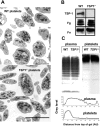
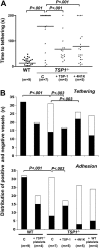
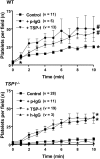
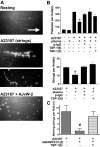
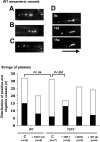
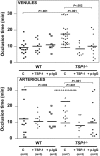

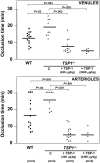
References
-
- Ruggeri ZM. Mechanisms initiating platelet thrombus formation. Thromb Haemost. 1997;78: 611-616. - PubMed
-
- Ware J, Ruggeri ZM. Platelet adhesion receptors and their participation in hemostasis and thrombosis. Drugs Today (Barc). 2001;37: 265-274. - PubMed
-
- Tuszynski GP, Nicosia RF. The role of thrombospondin-1 in tumor progression and angiogenesis. Bioessays. 1996;18: 71-76. - PubMed
Publication types
MeSH terms
Substances
Grants and funding
LinkOut - more resources
Full Text Sources
Other Literature Sources
Medical
Molecular Biology Databases
Miscellaneous

